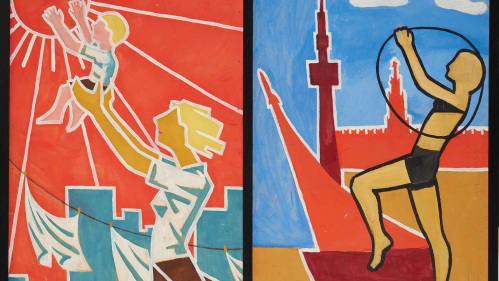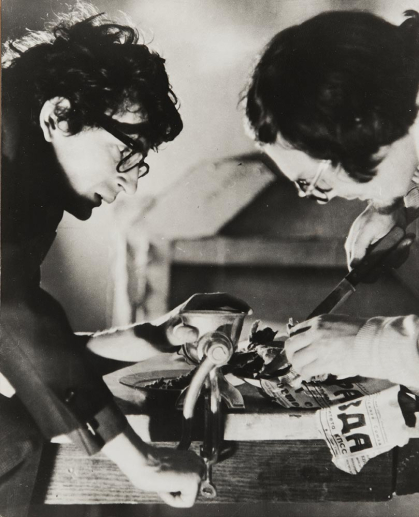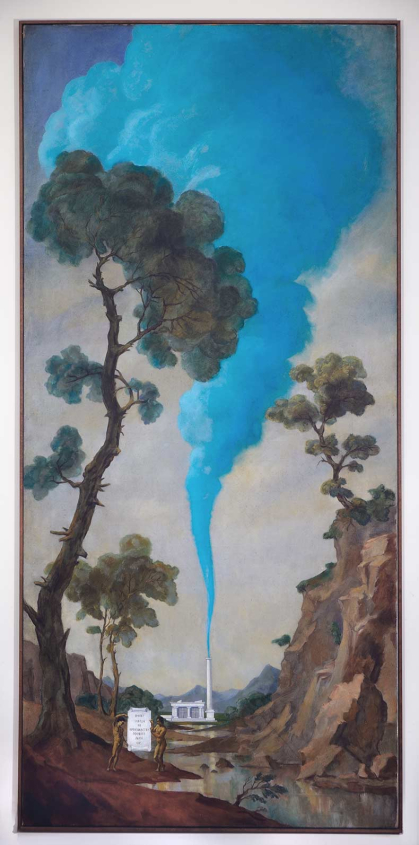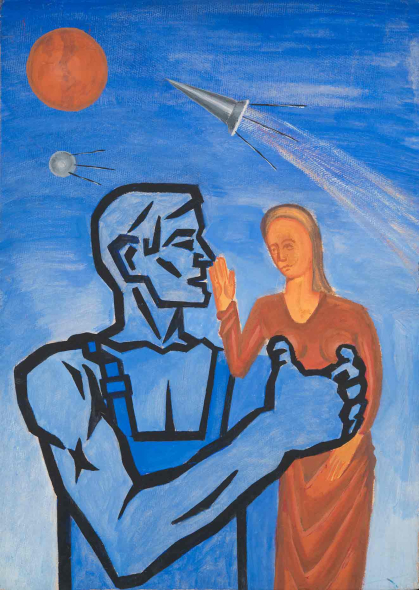The Art of Resisting Soviet Oppression: Zimmerli Showcases Fight Against a Regime

Komar and Melamid: A Lesson in History, a retrospective of two renowned artists and critics of the totalitarianism behind the Iron Curtain, opens Feb. 11
Some people fight against oppression with weapons. Russian-born artists Vitaly Komar and Alexander Melamid chose to wield paint brushes dipped in mockery.
Tongue-in-cheek humor and sharp criticism of the Soviet Union, American capitalism and the art market will be on display in the Zimmerli Art Museum’s latest exhibition, Komar and Melamid: A Lesson in History, a retrospective of the artists, both U.S. immigrants who worked together from 1972 through 2003.

The exhibition – featuring installations, paintings and prints from the museum’s Norton and Nancy Dodge Collection of Nonconformist Art from the Soviet Union – opens Saturday, Feb. 11, and runs through July 16 at the Zimmerli, 71 Hamilton St., New Brunswick. Admission is free to the public. The exhibition includes loans from national and international institutions, such as the Centre Pompidou in Paris, Tate Modern in London and the Nasher Museum of Art at Duke University, as well as private collections.
Opening such an exhibition near the anniversary of Russia’s military invasion of Ukraine is not lost on museum officials.
“The art of Komar and Melamid is critical of a totalitarian regime and mocks Soviet idiosyncrasies and propaganda,” said Julia Tulovsky, the Zimmerli’s curator of Russian and Soviet nonconformist art.
The art of Komar and Melamid is critical of a totalitarian regime and mocks Soviet idiosyncrasies and propaganda.
Julia Tulovsky
Curator of Russian and Soviet nonconformist art, Zimmerli Art Museum
“It's important to know that they've lived longer in the U.S. than they lived in Russia,” said Maura Reilly, director of the Zimmerli, adding that Komar and Melamid “created this amazingly powerful political work in response to a repressive, totalitarian regime.”
“Komar and Melamid are dissonant artists, like Ai Weiwei and Tania Bruguera,” said Reilly, adding the exhibition is a compelling example of “artists using their work to fight oppression – a struggle that persists throughout the world today.”

Noting both Russia’s oppression and propaganda surrounding the nation’s war with Ukraine, the exhibition is both timely and relevant to today’s audience, Zimmerli officials said. They emphasized the museum is a natural place to host such an exhibition: The Zimmerli holds the largest collection in the world of Soviet nonconformist art – more than 20,000 works by 1,000-plus artists – thanks to a 1991 donation from collectors Norton and Nancy Dodge.
“Their intellectual wit and tongue-in-cheek (dis)obedience to both ossified Soviet rules and clichés in American culture supplied them with a unique place in the art of both countries, as well as globally,” Tulovsky wrote in an essay about Komar and Melamid in the exhibition catalog. “Mixing and matching elements of different art styles, cultures, or political systems, [Komar and Melamid] unite a variety of often opposite and contradictory phenomena with an enviable ease.”
Tulovsky, who organized the exhibition, described it as “very funky, very funny,” adding that Komar and Melamid “are important artists for our collection, for the history of Soviet nonconforming art and also play a significant role in the contemporary American art scene.”
Descriptive wall texts about the art will help museum visitors understand the nuances of the satire and irony infused in the duo’s work.
Several events are slated during the exhibition:
-
An opening reception is set from 4 p.m. to 7 p.m. Saturday, Feb. 11, in the Lower Dodge Gallery.
-
Tulovsky will discuss the work of Komar and Melamid with Robert Storr, an art critic, curator and artist, from 2 p.m. to 3 p.m. Sunday, Feb. 12, in the Lower Dodge Gallery.
-
After the discussion with Storr, there will be a reenactment of a Komar and Melamid performance called “Art Belongs to People,” which the duo presented in 1974 in Moscow and 1984 in The Kitchen, an avant-garde performance space in New York. It starts at 3 p.m. in the Special Exhibition Gallery.
-
The Zimmerli hosts “Art Together,” a free, drop-in family art-making workshop inspired by the exhibition, from 1 p.m. to 3 p.m. on May 21 in the MAX classroom.
-
Also on May 21, the museum is holding two events from 2 p.m. to 5 p.m.: "The Diagnosis," a puppet show inspired by Melamid and organized by Lawrence Krauser and Olga Okuneva; and a spiritual séance with Melamid. Artist Liz Laser and spirit medium Lauren Thibodeau will lead the workshop.
-
A concert featuring music from The People's Choice project by Komar, Melamid and composer Dave Soldier will be held from 2 p.m. to 4 p.m. on June 11 in the Lower Dodge Gallery.
-
The Zimmerli also is presenting Alex Melamid and the Incoherents, which opens Feb. 11 in the Machaver Gallery and runs through July 16. The exhibition features a selection of puppets, shadow theater props and posters as well as satirical prints and drawings – along with new works by Melamid.

In conjunction with Komar and Melamid: A Lesson in History, the Zimmerli will present recent works by Komar in the museum’s lobby. Born of a Jewish mother and Ukrainian father, Komar refers to symbols from multiple cultures in his reflections on tragedies of our times. For example, an image of a bear – symbolizing Russian aggression in Ukraine – is shown next to images of two calamities the artist witnessed while living in New York: the destruction of the World Trade Center on Sept. 11, 2001, and the COVID-19 pandemic.
Born in Moscow, Komar and Melamid emerged from the circle of Soviet nonconformist artists who rejected the government’s dictate that limited artists to the propaganda-based style of Socialist Realism. The two immigrated to the U.S. in 1978.
Komar and Melamid founded Sots Art, a style that employs a provocative, ironic approach to expose the absurdities of the official Soviet art and of the regime as a whole. As with American Pop Art’s reaction to the overproduction of consumer goods, Sots Art was a reaction to the overproduction of ideology that rendered Communist slogans and symbols nonsensical.


